![]()
by Donna De Palma; uncredited photos by Jane Milliman
Creating borders of fragrant, flowering herbs or adding clusters of herbs to a flower garden is a delightful way to introduce scent. To select herbs that will complement existing elements in your garden, consider size, how quickly they reseed, blooming season, and most importantly, color and scent. Cultivating herbs to stand side-by-side with perennials is a tradition going back centuries. Informal, modern cottage gardens, especially, mix ornamental and edible plants freely.
Here are some herbs that do well in flower gardens with careful placement and proper care.

Lavender
Lavender is a wonderful choice if you need a swath of color from a hardy plant that blooms in mid-summer and can tolerate heat. The most common types are English and French lavender. English lavender produces blue-violet flowers on tall, slender stalks with narrow, silver-green leaves. Hybrids come in pastel colors: pale pink, lavender, and white, with foliage that varies in shape and color. Pair it with roses for a classic cottage garden look, or plant along walkways and paths to heighten the scent or as an accent plant in a container garden. If you would like to plant more than those types, look for Spanish and Portuguese lavender. Your garden will be abloom with lavender all summer long in repeating subtle yet varied shades of violet as one variety fades and the next blooms.
Lavender is also a natural pest repellent. Consider planting it near outdoor seating to repel mosquitos and attract butterflies. A tough perennial, lavender will last for several years if conditions are right. Find a sunny place with dry soil to plant. Lavender is well suited to container gardens and will thrive indoors in winter if exposed to at least eight hours of sun a day.

Anise hyssop courtesy Flickr: Green Mountain Girls
Another delicate and aromatic herb that grows well in gardens is anise hyssop, a flowering perennial of the mint family well suited as an ornamental. The faint scent of anise from leaves and flowers wafts from these bushy clumps of upright stems topped with fuzzy spikes of blue violet flowers. It will flower from June to September and can grow up to four feet by mid-to-late summer and reseeds freely. If you’d rather it didn’t spread, pinch off the flower heads before the small black seeds mature and drop. A location with full or partial sun works best. Anise hyssop prefers well-drained soil, attracts butterflies, and is a low-maintenance addition to any garden.

Marsh mallow courtesy Flickr: Amanda Slater
One of my favorite herbs for its delicate appearance is marsh mallow. Its pale white, hollyhock-like flowers with clustered lilac stamen and central anthers bloom nearly all summer long. With broad, grey-green leaves that are velvety soft, it’s an upright perennial that can last into early fall. A tall perennial, it performs well in the back border, though sometimes needs to be staked. This herb grows up to three feet and prefers full to partial sun but is adaptable. True to tis common name, the root was once used to make marshmallows.
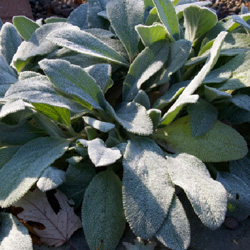
Sage
Sage is an herb with a pine-like aroma, delicate flowers, and soft foliage. Sage can be a perennial or an annual and comes in both blooming and nonblooming varieties. Pineapple sage, a relatively exotic strain, is a tender perennial with stalks of tubular scarlet blooms and a subtle scent of pineapple that butterflies and hummingbirds love.
In the summer, common garden sage usually produces lavender or blue-violet flowers atop shapely leaves. The flowers are edible as decorations on cakes, in salads, or as a garnish. It’s tastiest as a culinary herb when it gets loads of sunlight. Replace it every three to four years or keep it cut back hard, as it will lose its vigor and aroma, left to sprawl about.
Sage can grow almost anywhere. It’s ideal for planting along walkways and in corners of flowerbeds, providing a soft backdrop for brighter colors. The hardy versions of these subshrubs are drought tolerant and enjoy full sun.

Purple coneflower
Purple coneflower, a flowering herb otherwise known as Echinacea purpurea, blooms as large, rosy-pink flowers with raised orange-brown centers on sturdy stems. A hardy, drought-resistant perennial in the sunflower family, its daisy-like flower heads have a cone in the center with petals angled backward away from it.
Bred in a wide range of colors, the flowers are primarily pink, purple and lavender. Most have oval leaves with a wide base. They grow, on average, to two to four feet and need at least five hours of sunlight each day. Coneflowers bloom from early- to mid-summer and will thrive until the first frost. They’re rich in nectar, making them popular with bees and butterflies. Leave them standing in winter as food for birds.
At the first hint of spring growth, shear coneflower back for fuller foliage that will hold blooms longer. Coneflowers are prolific bloomers that will self-seed and spread. Large swathes of them can be placed next to ornamental grasses, black-eyed Susan, or culver’s root for a carpet-like display.

Catmint courtesy Flickr: Tanaka Juuyoh
Catmint, with its grey-green leaves and lavender blue flowers, can be used as edging or draped over stone borders. Easy to grow, these full, flowering stalks will hang over a terraced edge in a billowy tuft. Catmint is only slightly aromatic. Overhanging spikey flowers bloom in early summer and repeat their blooms throughout the summer and early fall. Pair with ornamental grasses, white lace flower, or lady’s mantle.
A tough, deer-resistant perennial that’s also drought-tolerant, catmint can grow from six inches to eight feet, and, in addition to bluish lavender, comes in a variety of soft colors, like pink, white and yellow. It pairs well with brightly colored perennials, surrounding them with a blanket of pastel. It can be sheared back after its initial flowering to encourage further blossoms.
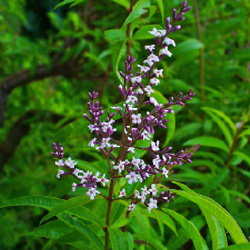
Lemon verbena courtesy H. Zell
No aromatic garden is complete without the delightfully pungent scent of lemon verbena, a bushy herb with a sweet, lemony scent and delicate pink or white flowers. Treat it as an annual in your summer garden, plant in a container garden, or take it indoors in winter—it’s an herb that prefers warmth.
The scent is primarily in the leaves, although the small, edible flowers can be used for teas, oils and vinegars. Its pretty white flowers bloom from late summer to fall, and with regular shaping, these plants can grow six feet high.

Rosemary courtesy Flickr: Tony Alter
Rosemary, a woody, evergreen-like perennial with creamy white, pale pink, violet, or brilliant blue flowers, blooms in early summer and is an aromatic, flowering herb that will provide contrast to other foliage in your garden with its deep green needles. Rosemary is a warm-weather herb and great choice for a container garden that can be moved indoors when the temperatures drop. This herb prefers a sunny spot with good drainage. Both ornamental and edible, it’s a summer hedge with a recognizably French aroma. ‘Tuscan Blue’ and ‘Spice Island’ are top choices in the kitchen.
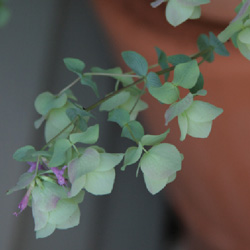
Ornamental oregano
Ornamental oregano is such a useful, deer-resistant, creeping perennial herb that it’s surprising we don’t see more of it in flower gardens. Beautiful in a rock garden as a trailer, its blue-green foliage and drooping, hop-like flowers of pink, violet, green, and cream also work well in a container garden, or as ground cover in an ornamental summer garden. Draped over a wall, terrace or edging, ornamental oregano prefers full sun and grows to a height of six to eight inches, spreading from 12 to18 inches. It even grows well in stone walls. Rather than as a culinary herb, it is known for its unusual beauty. Flowers hold their bloom for up to four months.

Bergamot
Bergamot or bee balm is considered a tea herb with a spicy, citrusy flavor, but it works beautifully in an ornamental garden. Its narrow, tubular, blue-violet flowers bloom from July through September and blossoms can range from lavender to deep red and attract butterflies, hummingbirds, and, especially, bees. Leaves can be used to flavor lemonade, teas, and essential oils. Bergamot forms dense clumps of erect stems that can grow to four feet tall, and looks a little like a chrysanthemum on a high stalk. It likes partial to full sun.
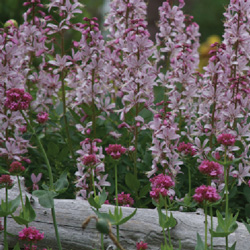
Valerian
Valerian, with fragrant lilac, pink or (usually) white flowers on long stalks, is a charming addition to an ornamental garden if you’re looking for an early summer bloom and don’t mind a tough competitor. Valerian can grow up to five feet and will get spindly, so it’s best placed near a wall or toward the back of a perennial garden. Try it next to poppies to contrast brilliant splashes of red, orange, yellow-orange, and coral with valerian’s pale flower. Watch out when digging up the roots, though—they don’t have a pleasant scent.
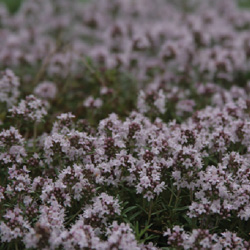
Lemon scented thyme
No aromatic or ornamental garden is complete without lemon-scented thyme, with pale lavender and pink flowers that bloom in spring. Sporting hardy foliage, this thyme is a compact bushy herb that reaches about 12 inches high by 12 inches wide. A full sun aromatic, it can be picked as a culinary herb that goes a long way in the kitchen. Lemon-scented thyme is the perfect choice for a border in the perennial garden. Mix in this splash of yellow green with the blues of iris, bellflower, or brunnera, and you’ve created a stunning color palette that leaves a lasting impression.
Whether your garden flowers with dahlia, peonies, daylilies or primrose, fill in corners, edges and walkways with aromatic flowering herbs for a signature cottage garden look that is uniquely yours. You’ll find that cultivating flowering herbs will become a pleasure all its own.
Donna De Palma is a freelance writer based in Rochester.
Views: 1




